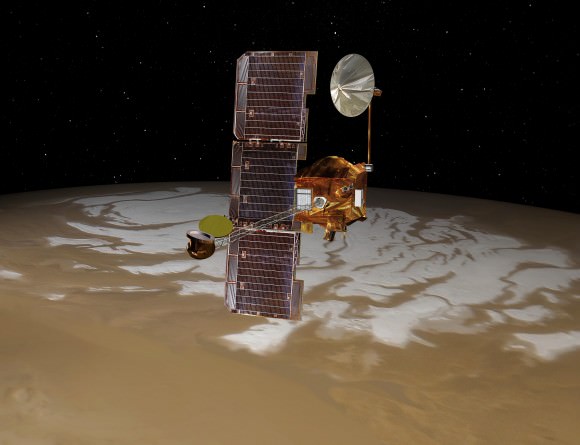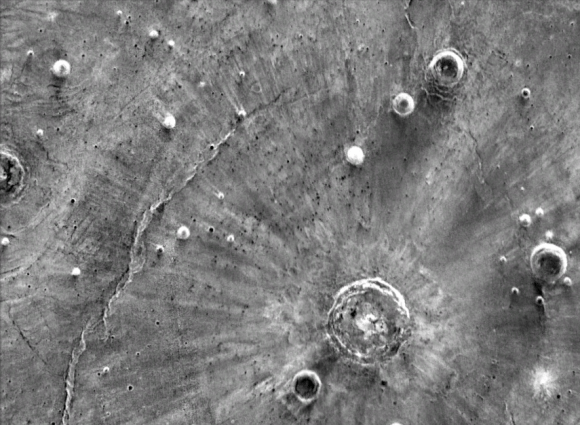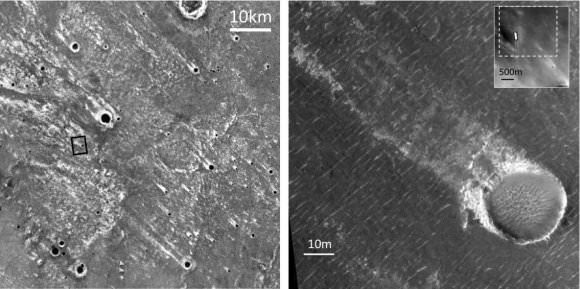The study of another planet's surface features can provide a window into its deep past. Take Mars for example, a planet whose surface is a mishmash of features that speak volumes. In addition to ancient volcanoes and alluvial fans that are indications of past geological activity and liquid water once flowing on the surface, there are also the many impact craters that dot its surface.
In some cases, these impact craters have strange bright streaks emanating from them, ones which reach much farther than basic ejecta patterns would allow. According to a new research study by a team from Brown University, these features are the result of large impacts that generated massive plumes. These would have interacted with Mars' atmosphere, they argue, causing supersonic winds that scoured the surface.
These features were noticed years ago by Professor Peter H. Schultz, a professor of geological science with the Department of Earth, Environmental, and Planetary Sciences (DEEPS) at Brown University. When studying images taken at night by the Mars Odyssey orbiter using its THEMIS instrument, he noticed steaks that only appeared when imaged in the infrared wavelength.

Artist's conception of the Mars Odyssey spacecraft. Credit: NASA/JPL
These streaks were only visible in IR because it was only at this wavelength that contrasts in heat retention on the surface were visible. Essentially, brighter regions at night indicate surfaces that retain more heat during the day and take longer to cool. As Schultz explained in a Brown University press release, this allowed for features to be discerned that would otherwise not be noticed:
"You couldn't see these things at all in visible wavelength images, but in the nighttime infrared they're very bright. Brightness in the infrared indicates blocky surfaces, which retain more heat than surfaces covered by powder and debris. That tells us that something came along and scoured those surfaces bare."
Along with Stephanie N. Quintana, a graduate student from DEEPS, the two began to consider other explanations that went beyond basic ejecta patterns. As they indicate in their study - which recently appeared in the journal Icarus under the title "Impact-generated winds on Mars" - this consisted of combining geological observations, laboratory impact experiments and computer modeling of impact processes.
Ultimately, Schultz and Quintana concluded that crater-forming impacts led to vortex-like storms that reached speeds of up to 800 km/h (500 mph) - in other words, the equivalent of an F8 tornado here on Earth. These storms would have scoured the surface and ultimately led to the observed streak patterns. This conclusion was based in part on work Schultz has done in the past at NASA's Vertical Gun Range.

An infrared image revealing strange bright streaks extending from Santa Fe crater on Mars. Credit: NASA/JPL-Caltech/Arizona State University.
This high-powered cannon, which can fire projectiles at speeds up to 24,000 km/h (15,000 mph), is used to conduct impact experiments. These experiments have shown that during an impact event, vapor plumes travel outwards from the impact point (just above the surface) at incredible speeds. For the sake of their study, Schultz and Quintana scaled the size of the impacts up, to the point where they corresponded to the impact craters on Mars.
The results indicated that the vapor plume speed would be supersonic, and that its interaction with the Martian atmosphere would generate powerful winds. However, the plume and associated winds would not be responsible for the strange streaks themselves. Since they would be travelling just above the surface, they would not be capable of causing the kind of deep scouring that exists in the streaked areas.
Instead, Schultz and Quintana showed that when the plume struck a raised surface feature - like the ridges of a smaller impact crater - it would create more powerful vortices that would then fall to the surface. It is these, according to their study, that are responsible for the scouring patterns they observed. This conclusion was based on the fact that bright streaks were almost always associated with the downward side of a crater rim.

IR images showing the correlation between the streaks and smaller craters that were in place when the larger crater was formed. Credit: NASA/JPL-Caltech/Arizona State University
As Schultz explained, the study of these streaks could prove useful in helping to establish that rate at which erosion and dust deposition occurs on the Martian surface in certain areas:
"Where these vortices encounter the surface, they sweep away the small particles that sit loose on the surface, exposing the bigger blocky material underneath, and that's what gives us these streaks. We know these formed at the same time as these large craters, and we can date the age of the craters. So now we have a template for looking at erosion."
In addition, these streaks could reveal additional information about the state of Mars during the time of impacts. For example, Schultz and Quintana noted that the streaks appear to form around craters that are about 20 km (12.4 mi) in diameter, but not always. Their experiments also revealed that the presence of volatile compounds (such as surface or subsurface water ice) would affect the amount of vapor generated by an impact.
In other words, the presence of streaks around some craters and not others could indicate where and when there was water ice on the Martian surface in the past. It has been known for some time that the disappearance of Mars' atmosphere over the course of several hundred million years also resulted in the loss of its surface water. By being able to put dates to impact events, we might be able to learn more about Mars' fateful transformation.
The study of these streaks could also be used to differentiate between the impacts of asteroids and comets on Mars - the latter of which would have had higher concentrations of water ice in them. Once again, detailed studies of Mars' surface features are allowing scientists to construct a more detailed timeline of its evolution, thus determining how and when it became the cold, dry place we know today!
Further Reading: Brown University, Science Direct
No comments:
Post a Comment